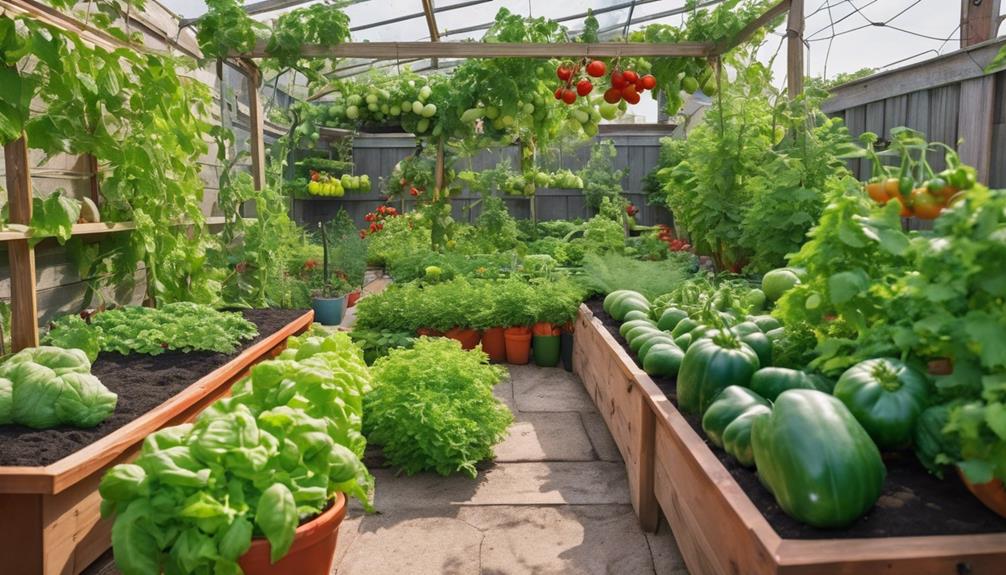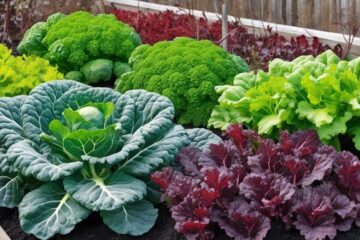When tending to your small garden veggies, remember that pruning is key to maintaining plant health and productivity. By understanding the proper techniques for different types of plants, you can effectively shape their growth and boost overall yield.
But what about the lesser-known benefits of pruning that go beyond just aesthetics? Let’s explore how strategic pruning can unlock the full potential of your garden veggies, leading to healthier plants and bountiful harvests.
Importance of Pruning for Garden Veggies
Pruning vegetable plants regularly enhances their growth and overall health. By trimming excess leaves, you allow for better air circulation and light penetration, vital for optimal plant development.
Redirecting the plant’s energy through pruning also encourages the production of high-quality fruits. Moreover, pruning plays a crucial role in preventing diseases and pest infestations, as it helps maintain the plant’s health and vigor.
Removing any diseased or damaged parts through pruning supports the plant’s overall productivity. Ultimately, pruning is essential for maximizing yields and ensuring the longevity of your vegetable plants.
Pruning Techniques for Small Gardens
Caring for small gardens involves a strategic approach to pruning – the selective removal of plant parts. This practice is crucial for enhancing growth, productivity, and the overall health of your vegetable garden. Here’s how to refine your pruning techniques for better yields, especially for tomatoes and other vegetables:
- Start from the Bottom:Effective pruning begins at the lower part of the plant. This involves:
- Identifying and Removing Health Threats: Look for any signs of disease or pest infestation on stems and leaves. Removing these parts early can prevent the spread of disease and reduce pest issues.
- Enhancing Plant Foundation: By focusing on the base, you ensure the plant’s energy is directed upwards, supporting healthy growth and development.
- Redirect Energy:To ensure your fruiting plants concentrate their resources on fruit production:
- Prune Non-Essential Leaves: Regularly remove leaves that do not contribute to fruit development. This helps in redirecting the plant’s energy towards growing robust fruits.
- Manage Flower Heads: Pruning flower heads on certain vegetables can also encourage the plant to focus more on fruit production rather than foliage.
- Improve Air Flow:Trimming excess foliage is more than just an aesthetic practice:
- Disease Prevention: By improving air circulation around the plants, you significantly reduce the humidity that can lead to fungal diseases.
- Optimal Growth Conditions: Good airflow is essential for photosynthesis, which plants rely on for growth and fruit production.
Maximizing Growth Through Pruning
To enhance growth and maximize the potential of your small garden vegetables, mastering the art of selective pruning is essential.
Pruning redirects plant energy towards areas that need it most, promoting optimal growth and fruit development. By removing excess foliage, you improve airflow and light penetration, reducing the risk of diseases and pests. Different vegetables may require specific pruning techniques to ensure they reach their full potential.
Pruning is a fine art that, when mastered, can significantly enhance the growth and productivity of your small garden vegetables:
- Selective Pruning: Understanding which parts of the plant to prune and when can make a significant difference in growth and yield.
- Promoting Healthier Plants: Regular pruning encourages plants to produce new, healthy growth. This is particularly beneficial during the warmer months, as it can lead to larger yields and more vigorous plants.
Additionally, pruning stimulates new growth, leading to healthier plants overall. Especially in the summer, effective pruning can result in bigger yields and robust, thriving plants.
Common Pruning Mistakes to Avoid
Be mindful of the detrimental impact that over-pruning can have on your small garden vegetables. Over-pruning can stress plants, leading to reduced productivity and plant vulnerability to pests and diseases.
Avoid pruning at the wrong time, as it can leave plants susceptible to external threats. Additionally, failing to sterilize your pruning tools can result in the spread of diseases among plants.
Aggressive pruning should also be avoided since it can stunt plant growth, hinder fruit production, and cause plant damage. Remember, proper pruning techniques are essential for maintaining the health and vigor of your small garden veggies.
The top common mistakes are:
- Over-Pruning: This can stress the plants, making them less productive and more susceptible to diseases and pests.
- Improper Timing: Pruning at the wrong time can expose plants to adverse conditions, affecting their growth and health.
- Tool Sanitation: Failing to sterilize pruning tools can lead to the spread of diseases between plants.
- Aggressive Pruning: Removing too much of the plant can stunt its growth, reduce fruit production, and even cause irreversible damage.
Seasonal Pruning Tips for Vegetables
Wondering how seasonal pruning can enhance the growth and productivity of your vegetable garden?
Understanding how to prune your vegetables seasonally can greatly enhance their growth and productivity:
- Tomatoes: Recognizing whether your tomatoes are determinate or indeterminate varieties can guide how you prune them for optimal fruit production.
- Cucumbers, Peppers, Zucchini, and Squash: These plants benefit from pruning to manage their size, improve air circulation, and encourage fruit development.
- Seasonal Adjustments: Adapting your pruning techniques according to the season can help in managing plant growth, ensuring that your vegetables remain healthy and productive throughout their growing cycle.
By incorporating these detailed pruning strategies, you can significantly improve the health, growth, and yield of your small garden vegetables, ensuring a bountiful harvest season after season.
Frequently Asked Questions
When Should I Prune My Vegetable Garden?
You should prune your vegetable garden when plants are actively growing to encourage new growth and fruit production. Morning pruning aids healing, while avoiding evening pruning helps prevent moisture-related diseases. Regular maintenance throughout the season promotes plant health.
What Vegetables Can Be Pruned?
You can prune various veggies like tomatoes, peppers, cucumbers, and leafy greens for better growth and yield. Think of pruning as giving your plants a spa day—it redirects energy, prevents diseases, and helps them thrive.
Should I Cut the Dead Leaves off My Vegetable Plants?
Yes, you should cut the dead leaves off your vegetable plants. Doing so prevents diseases and pests, redirects plant energy for new growth, and enhances airflow and sunlight exposure, promoting overall plant health and productivity.
How Do You Trim a Vegetable Garden?
To trim a vegetable garden, start by pruning from the bottom up for plant health. Remove diseased parts to prevent spread. Trim leaves on fruiting plants to boost fruit growth. Regularly trim flowers to encourage continuous blooming.
Conclusion
So remember, don’t be afraid to get your hands dirty and give those veggie plants some love through pruning.
Just like a sculptor shapes a masterpiece from a block of marble, pruning helps you sculpt your garden into a beautiful work of art.
With a little care and attention, your small garden will flourish and yield bountiful harvests.
Happy pruning and happy gardening!





